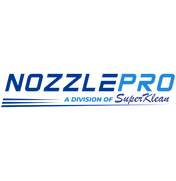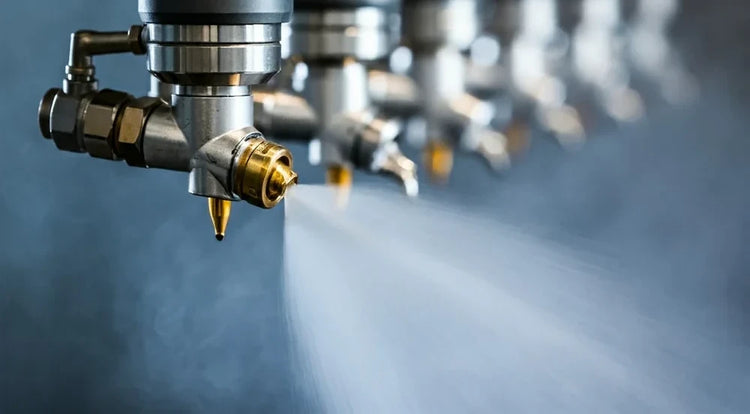Spray Optimization Guide: Maximize Efficiency & Reduce Costs
Learn proven strategies to optimize your spray system through proper pattern selection, nozzle configuration, maintenance, and pressure adjustment. Discover how to reduce waste, improve quality, and lower operational costs.
At NozzlePro, we understand that optimizing your spray system is essential to achieving peak operational performance. Whether you're in food & beverage, automotive, chemical processing, or any industrial application, the right spray optimization strategy can dramatically improve your results while reducing both costs and environmental impact.
This comprehensive guide walks you through the five core elements of spray optimization and provides actionable strategies you can implement immediately to see measurable improvements in efficiency, quality, and cost savings.
Why Spray Optimization Matters
Proper spray optimization delivers measurable ROI across multiple operational dimensions. Here's what you can expect:
Increased Efficiency
Optimize spray patterns and flow rates to reduce waste, accelerate processes, and enhance overall productivity. Systems operating at peak efficiency produce better coverage in less time.
Cost Savings
Minimize resource usage and maintenance costs by ensuring your system runs efficiently. Proper optimization reduces liquid consumption, energy usage, and unexpected downtime by 20-40%.
Enhanced Quality
Achieve consistent, high-quality results with precise spray control. Optimized systems deliver uniform coverage, better coating adhesion, and more predictable outcomes every time.
Environmental Impact
Reduce your environmental footprint by optimizing resource consumption and minimizing waste. Lower chemical usage and reduced overspray benefit both your bottom line and the planet.
Five Key Factors in Spray Optimization
Master these five critical elements to unlock your spray system's full potential:
1 Spray Pattern Selection
The spray pattern is the foundation of your optimization strategy. Each pattern type is engineered for specific applications and delivers unique benefits. Choosing the wrong pattern is one of the most common reasons spray systems underperform.
- Flat Fan: Washing, rinsing, conveyor cleaning—requires high impact force and concentrated coverage
- Hollow Cone: Cooling, humidification, coating—delivers fine atomization and even distribution
- Full Cone: General industrial, dust suppression—creates uniform circular coverage
- Misting: Humidification, odor control—produces ultra-fine droplets
2 Nozzle Selection & Configuration
The right nozzle maximizes spray performance for your exact application. Nozzle selection involves balancing flow rate, pressure, spray angle, and material compatibility. A poorly matched nozzle can waste 10-20% of your spray liquid through overspray or uneven coverage.
- Flow rate (GPM) matches your application requirements
- Material compatibility handles your specific liquid (corrosive chemicals, abrasive slurries, etc.)
- Pressure rating accommodates your system's PSI
- Spray angle provides proper coverage area
Actionable Tip: Browse our complete nozzle collection organized by pattern type and application.
3 System Maintenance Protocol
Regular maintenance is crucial for sustained optimal performance. A well-maintained system operates more efficiently, lasts longer, and produces more consistent results. Preventive maintenance is always more cost-effective than reactive repairs.
- Weekly: Visually inspect for leaks or obvious damage; clean external surfaces
- Monthly: Deep clean nozzles; check for clogging or wear patterns
- Quarterly: Inspect seals and connections; replace worn components
- Annually: Full system pressure test; calibrate flow rates; replace aged internal components
4 Pressure & Flow Rate Optimization
Proper pressure and flow rate settings directly impact spray performance, efficiency, and cost. Operating outside optimal ranges leads to poor atomization, uneven coverage, accelerated wear, and higher energy costs. Finding your system's sweet spot is key to optimization.
- Establish baseline measurements of current pressure and flow rate
- Test recommended settings for your nozzle type
- Measure results in real operating conditions
- Document optimal settings for your specific application
- Monitor pressure over time to detect system degradation
Pro Tip: Most industrial nozzles operate efficiently between 40-400 PSI. Operating below the minimum pressure causes poor atomization; above the maximum accelerates nozzle wear.
5 Spray Coverage & Distribution
Achieving even spray coverage across your target area ensures consistent results and eliminates waste from overspray. Poor coverage distribution often indicates suboptimal nozzle positioning, pressure, or angle selection.
- Conduct coverage testing using simple detection methods (wet paper, dye tracing)
- Measure spray angle and verify it matches design specifications
- Assess droplet size distribution for consistency
- Adjust nozzle positioning to eliminate coverage gaps
- Use multiple nozzles if single-point coverage is insufficient
Tools & Resources for Spray Optimization
Access our comprehensive suite of resources designed to make spray optimization easy and effective:
Spray Optimization Guide
Download our comprehensive PDF guide covering all aspects of spray system optimization, including detailed checklists, maintenance schedules, and calculation formulas.
Download Guide (PDF) →Interactive Nozzle Search
Use our advanced nozzle search tool to find the perfect nozzle for your specific application. Input your requirements, and get tailored recommendations with flow charts and specifications.
Browse Nozzles & Search Tool →Technical Articles & Case Studies
Read real-world examples of how spray optimization has transformed operations in food processing, automotive, chemical, steel, and wastewater treatment industries.
Read Articles & Case Studies →Spray Pattern Reference Library
Access detailed specifications and visual comparisons of all spray pattern types. Understand the mechanical differences and performance characteristics that drive pattern selection.
Explore All Patterns →ROI Calculator
Use our ROI calculator to estimate potential cost savings from spray system optimization specific to your application, usage patterns, and current waste rates.
Request ROI Analysis →Expert Consultation
Schedule a free consultation with our spray optimization specialists. We'll assess your current system and provide personalized recommendations for improvement.
Schedule Consultation →Frequently Asked Questions
Quick answers to common spray optimization questions:
What is spray optimization and why is it important?
Spray optimization is the process of fine-tuning your spray system to maximize efficiency, reduce waste, improve quality, and lower operational costs. It's important because even small inefficiencies compound over time, leading to significant waste of liquid, energy, and resources. Optimized systems typically deliver 20-40% cost savings and 25-35% productivity improvements.
How can spray optimization reduce my operating costs?
Optimization reduces costs through multiple mechanisms: minimizing liquid waste through proper nozzle selection and pressure settings, reducing energy consumption by operating at optimal pressure levels, decreasing maintenance costs through preventive protocols, extending equipment lifespan, and reducing unplanned downtime. Most facilities see ROI within 6-12 months of optimization.
How do I know which spray pattern to choose?
Spray pattern selection depends on your specific application. Flat fan patterns provide high-impact coverage for washing and cleaning; hollow cone patterns deliver fine mist for cooling and coating; full cone patterns offer uniform coverage for general industrial use; and misting patterns create ultra-fine droplets for humidification. Start with your application requirements, then refer to our spray pattern selection guide.
What's the difference between PSI and GPM, and how do they affect optimization?
PSI (pounds per square inch) is the pressure—the force behind the spray. GPM (gallons per minute) is the flow rate—how much liquid is delivered. Both must be properly calibrated for your nozzle and application. Incorrect pressure reduces atomization quality or increases wear; incorrect flow rate leads to under or over-spraying. Optimizing both together maximizes efficiency.
How often should I perform maintenance on my spray system?
Maintenance frequency depends on usage intensity and liquid type. Weekly visual inspections are recommended for all systems. Monthly deep cleaning of nozzles is standard for most applications. Quarterly inspections of seals and connections, and annual full system audits ensure peak performance. Harsh chemical or abrasive applications may require more frequent maintenance.
Can optimization work for my specific application?
Yes. Spray optimization principles apply across all industrial applications—from food & beverage to automotive to chemical processing to steel manufacturing to wastewater treatment. Every industry benefits from proper nozzle selection, pressure optimization, and maintenance protocols. Our specialists can assess your specific situation and recommend targeted optimizations.
What's the quickest way to see improvement?
The fastest improvements typically come from three changes: (1) Verifying your current nozzle is correctly sized for your application, (2) Optimizing pressure settings to the recommended range for your nozzle type, and (3) Implementing a basic cleaning/maintenance schedule. These three changes alone often deliver 15-25% efficiency improvements within days.
How can NozzlePro help with my optimization?
We offer comprehensive support: expert consultation to assess your current system, nozzle selection guidance based on your specific requirements, access to optimization tools and resources, technical documentation and case studies, and ongoing support to ensure your optimized system maintains peak performance.
Ready to Optimize Your Spray System?
Start improving efficiency and reducing costs today. Our experts are ready to help you find the perfect optimization strategy for your unique application.
Explore Solutions Get Expert AdviceExpert Support & Consultation
Our team of spray optimization specialists is here to help you achieve peak system performance. Whether you need help selecting the right nozzle, diagnosing an issue, or designing a complete optimization strategy, we're ready to support your success.
📞 Phone
Speak directly with a spray expert: 650-375-7002
📧 Contact Form
Submit detailed requirements and receive personalized recommendations: Send Message
📚 Free Resources
Download our optimization guide and access case studies: Download (PDF)
Related Resources & Guides
Expand your spray knowledge with our comprehensive resource library:

